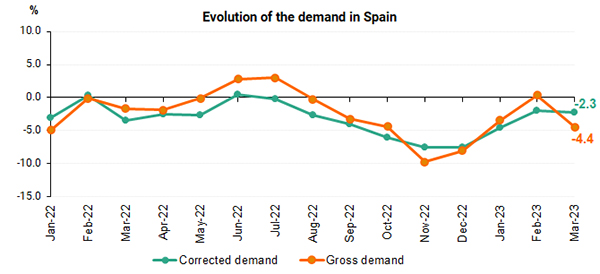For 40 years, we've been driving our country's economic and social progress. Four decades shaping Spain.
Demand for electricity in Spain fell by 2.3% in March
- Renewables generated 53% of the electricity production in Spain during March and 75.5% of the energy was obtained using zero-carbon energy technologies
- Solar photovoltaic doubled its monthly production compared to last year and wind energy continued to lead the national generation mix for the fifth month in a row
National electricity demand in March experienced a 2.3% decrease year-on-year after having factored in the influence of seasonal and working patterns. In gross terms, demand is estimated at 20,521 GWh, down 4.4% on March 2022.

In the first quarter of 2023, Spain recorded a cumulative demand of 62,715 GWh, 2.6% less than in the same period of 2022. Once again, after having factored in the influence of seasonal and working patterns, demand is down 3% compared to 2022.
During the month, renewable energy production was 22.9% higher than in March 2022, reaching 12,755 GWh, accounting for 53% of the total generation mix nationwide. In turn, electricity production obtained using zero-carbon energy technologies accounted for a 75.5% share of the overall mix.
For the fifth consecutive month, and according to provisional data available at the time of this press release, wind power was the leading source of energy, with a production of 6,718 GWh and a share of 27.9% of the total mix.
For its part, solar photovoltaic, with 3,015 GWh registered in March, doubled its production year-on-year, accounting for a share of 12.5% in the energy mix. The amount of GWh produced this month using solar photovoltaic technology is the highest since last August.
Hydro, whose share in March was up 25.4% year-on-year, reached 2,212 GWh, accounting for 9.2% of the total.

Demand for electricity in the peninsular system falls by 2.4%
Regarding the mainland system, and after having factored in the influence of seasonal and working patterns, demand for electrical energy was 2.4% lower than in March 2022. In gross terms, demand was 19,344 GWh, down 4.6% year-on-year.
In the first quarter of the year, electricity demand on the Spanish mainland stood at 59,224 GWh, down 2.7% on the same period in 2022. After having factored in the influence of seasonal and working patterns, demand dropped by 3.1%.
According to provisional data available at the time of this press release, the renewable power generation on the Spanish mainland accounted 54.6% of the total mix in March, registering a production of 12,543 GWh, up 22.8% year-on-year. Production obtained using zero-carbon energy technologies accounted for 78.2% of the total mix.
The energy generation mix on the mainland in March was also led by wind power, which accounted for 28.6% of the total, with a total production of 6,584 GWh during the month.
The electricity system in the Balearic Islands and the Canary Islands
Electricity demand in the Balearic Islands in March, after having factored in the influence of seasonal and working patterns, was 3.3% lower than in the same month in 2022. Thus, gross demand is estimated at 415,998 MWh, down 5.9% year-on-year. In the first three months of 2023, gross demand in the Balearic Islands is estimated at 1,297,713 MWh, down 0.5% on the same period of 2022.
In terms of generation, combined cycle, with a share of 72.1% of the energy produced in the Balearic Islands, was the leading energy source in the islands in March. For its part, renewable energy obtained using zero-carbon energy technologies in the Balearic Islands was 85.1% higher than in March 2022 and represented 13.3% of the total. In addition, during this month, the subsea link between the Spanish mainland and Majorca contributed to covering 19.8% of the electricity demand in the Balearic Islands.
Electricity demand in the Canary Islands, after having factored in the influence of seasonal and working patterns, grew by 2%, compared to the same month in 2022. In gross terms, demand was 728,371 MWh, up 2.3%. In the first quarter of 2023, demand in the Canary Islands is estimated at 2,096,639 MWh, up 1% on the same period of 2022.
With regard to electricity generation in the Canary Islands, combined cycle, with 41% of the total generation, was also the leading technology in March. Renewables and generation obtained using zero-carbon energy technologies produced 21.8% more than in the same period last year and reached a share of 23.1% of the total energy mix, with wind power contributing 18.4%.
Consult our Daily Balance Report for more information on the National, Peninsular, Balearic Islands and Canary Islands electricity systems as at the close of March.












